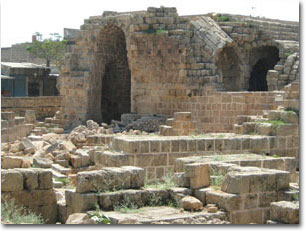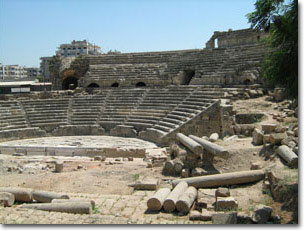|
 25 km
south of Lattakia we find Jableh which was part of the Principality of
Antioch, one of the Crusader States, until it was captured by Saladin
in 1189 during the Third Crusade. This city was inhabited from the 3rd
millennium BC. 25 km
south of Lattakia we find Jableh which was part of the Principality of
Antioch, one of the Crusader States, until it was captured by Saladin
in 1189 during the Third Crusade. This city was inhabited from the 3rd
millennium BC.
This town served as a small port from the Phoenician period to the
present. It is mentioned in the Assyrian records as part of the
Assyrian Empire but received a Greek colony. It formed part of the
confederation of Phoenicians states controlled by Arwad (island of
Aradus) in the Persian and Seleucid periods. It passed through the usual hands that have occupied Syria and
flourished relatively under the Romans and the crusaders whence it was
split between the Templars and the Hospitables. It was important enough in the early Christian period to serve as the
seat of a Bishop but passed from the Byzantine to the Arabs in 638. The
Crusaders under Raymond count of Toulouse forced the local Muslim
judge, Fakhr al-Mulk Ibn Ahmar, to pay tribute in 1098, shortly after
the fall of Antioch. A while after, the Roman theater was turned into a
Crusader castle. In 1285 it was taken by the Mameluke Sultan Qalaun, and has been of
little importance since then. While Jeble has played a role in just
about every phase of Syrian history, the only substantial remains the
past has left it is a small Roman amphitheater that was big enough for
7000 people. It is over 90 meters across and originally had 30 rows,
although only 20 exist now. This theater was turned into a fortress by
the crusaders. The city is home to the tomb and the mosque of Sultan
Ibrahim Ibn Adham, a famous Muslim mystic who renounced his throne and
devoted himself to prayers for the rest of his life.  
|


